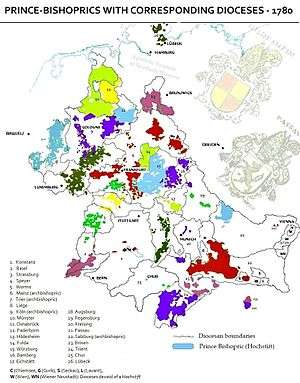Hochstift


In the Holy Roman Empire, the German term Hochstift (plural: Hochstifte or Hochstifter) referred to the territory ruled by a bishop as a prince, as opposed to his diocese, generally much larger and over which he exercised only spiritual authority.[1] The terms prince-bishopric (German: Fürstbistum, or simply Bistum) and ecclesiastical principality are synonymous with Hochstift. Erzstift referred to the territory ruled by a prince-archbishop while Stift referred to the territory ruled by an imperial abbot or abbess, or a princely abbot or abbess. Stift was sometime used also as a synonym of Hochstift.
The Hochstift was made of land mostly acquired in the Middle Age through donations by the king/emperor, bequests by local lords or through purchase. It was often made of non-contiguous parts, some of which could be located outside the bishop’s diocese. The prince-bishop, elected by the canons of the cathedral chapter and often belonging to the high nobility, enjoyed imperial immediacy; he wielded the same authority over his principality as any secular prince, such as a duke or a margrave, over his. He had seat and vote at the Imperial Diet.
From a high of approximately 40 in the late Middle Ages, the number of Hochstifte was down to 26[2] by the late 18th century. They had all been secularized and their territory absorbed by secular states by the time the Holy Roman Empire was dissolved in 1806.
Etymology and related and derived terms

Das Stift [plural: die Stifte or, in some regions, die Stifter]/het sticht [in Dutch] (literally, the "donation"), denotes in its original meaning the donated or else acquired fund of estates whose revenues are taken to maintain a college and the pertaining church (Stiftskirche, i.e. collegiate church) and its collegiate canons (Stiftsherr[en]) or canonesses (Stiftsfrau[en]).[3] If the Stift as a fund served to maintain the specific college of a cathedral (a so-called cathedral chapter) then the Stift was often called das Domstift (i.e. cathedral donation [fund]).
Hochstift is a compound with hoch ("high") used for a prince-bishopric, meaning literally a "high [ranking ecclesiastical] donation [fund of estates]".[4] Whereas Erzstift, a compound with Erz… ("arch[i]…"), was the corresponding expression for a prince-archbishopric.[5] For the three prince-electorates of Cologne (Kurköln), Mainz (Kurmainz) and Trier (Kurtrier), which were simultaneously archbishoprics the corresponding term is Kurerzstift (electorate-archbishopric). The adjective pertaining to Stift as a territory is stiftisch (of, pertaining to a prince-bishopric; prince-episcopal).[6] As a compound, the term Stift today usually takes the copulative "s" when used as a preceding compound,[7] such as in Stiftsadel (vassal nobility of a prince-bishopric), Stiftsamtmann (=official of a Stift[7]), Stiftsmann (plural: Stiftsleute; =vassal tenant of an estate of a Stift[8]), Stiftssasse (=subject/inhabitant of a prince-bishopric), Stiftsstände (=estates of a prince-bishopric as a realm[9]), or Stiftstag (diet of the estates of a prince-bishopric[9]).
Specific prince-bishoprics were often called Hochstift/Erzstift X, as in Hochstift Ermland or in Erzstift Bremen, with stiftbremisch meaning of/pertaining to the Prince-Archbishopric of Bremen, as opposed to stadtbremisch (of/pertaining to the city of Bremen). By contrast, the spiritual entities, the dioceses, are called Bistum ("diocese") or Erzbistum ("archdiocese") in German. The difference between a Hochstift/Erzstift and a Bistum/Erzbistum is not always clear to authors so that non-scholarly texts often translate Hochstift or Erzstift incorrectly simply as diocese/bishopric or archdiocese/archbishopric, respectively.
Notes
- ↑ Joachim Whaley, Germany and the Holy Roman Empire, Oxford University Press, 2012, volume 2, Glossary of German terms and other terms.
- ↑ Including the Archbishoprics-Electorates of Mainz, Trier and Cologne and the Archbishopric of Salzburg
- ↑ Victor Dollmayr, Friedrich Krüer, Heinrich Meyer and Walter Paetzel, Deutsches Wörterbuch (started by the Brothers Grimm): 33 vols. (1854–1971), vol. 18 'Stehung–Stitzig', Leipzig: Hirzel, 1941, cols. 2870seq., reprint: Munich: Deutscher Taschenbuch Verlag (dtv; No. 5945), 1984. ISBN 3-423-05945-1.
- ↑ Jacob Grimm and Wilhelm Grimm, Deutsches Wörterbuch: 33 vols. (1854–1871), vol. 10 'H–Juzen', Leipzig: Hirzel, 1877, col. 1634, reprint: Munich: Deutscher Taschenbuch Verlag (dtv; No. 5945), 1984. ISBN 3-423-05945-1.
- ↑ Jacob Grimm and Wilhelm Grimm, Deutsches Wörterbuch: 33 vols. (1854–1971), vol. 3 'E–Forsche', Leipzig: Hirzel, 1862, col. 1099, reprint: Munich: Deutscher Taschenbuch Verlag (dtv; No. 5945), 1984. ISBN 3-423-05945-1.
- ↑ Victor Dollmayr, Friedrich Krüer, Heinrich Meyer and Walter Paetzel, Deutsches Wörterbuch (started by the Brothers Grimm): 33 vols. (1854–1971), vol. 18 'Stehung–Stitzig', Leipzig: Hirzel, 1941, col. 2896, reprint: Munich: Deutscher Taschenbuch Verlag (dtv; No. 5945), 1984. ISBN 3-423-05945-1.
- 1 2 Victor Dollmayr, Friedrich Krüer, Heinrich Meyer and Walter Paetzel, Deutsches Wörterbuch (started by the Brothers Grimm): 33 vols. (1854–1971), vol. 18 'Stehung–Stitzig', Leipzig: Hirzel, 1941, col. 2874, reprint: Munich: Deutscher Taschenbuch Verlag (dtv; No. 5945), 1984. ISBN 3-423-05945-1.
- ↑ Victor Dollmayr, Friedrich Krüer, Heinrich Meyer and Walter Paetzel, Deutsches Wörterbuch (started by the Brothers Grimm): 33 vols. (1854–1971), vol. 18 'Stehung–Stitzig', Leipzig: Hirzel, 1941, cols. 2897seq., reprint: Munich: Deutscher Taschenbuch Verlag (dtv; No. 5945), 1984. ISBN 3-423-05945-1.
- 1 2 Victor Dollmayr, Friedrich Krüer, Heinrich Meyer and Walter Paetzel, Deutsches Wörterbuch (started by the Brothers Grimm): 33 vols. (1854–1971), vol. 18 'Stehung–Stitzig', Leipzig: Hirzel, 1941, col. 2900, reprint: Munich: Deutscher Taschenbuch Verlag (dtv; No. 5945), 1984. ISBN 3-423-05945-1.